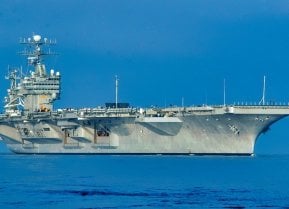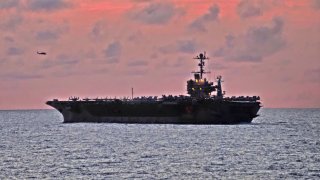The SubCarrier: Can the Navy Merge An Aircraft Carrier and Submarine?
During the Cold War, the United States Navy also considered a number of submarine aircraft carriers or what many call a SubCarrier – including vessels that could carry small bombers for strategic nuclear strikes.
A Submarine Aircraft Carrier – Has Its Time Finally Come? - Submarines and aircraft carriers would seem to be mutually exclusive concepts. One vessel can travel under the water, while the other can launch aircraft. However, since the adoption of the respective platforms, military planners have considered ways to integrate the two together.
The earliest efforts occurred during the First World War, when the German U-Boat SM U-12 transported a modified FF-29 seaplane across the English Channel. However, the submarine didn't actually travel submerged, rather the seaplane simply sat on its deck.
Various nations considered how a submarine could carry aircraft in the interwar era, including the UK's Royal Navy, which had been an early pioneer of naval aviation. In the 1920s, the HMS M2 was fitted with a small aircraft hanger that could carry a Parnall Peto seaplane that was modified for service from the submarine. It had to be lowered into the sea by a derrick for takeoff and after landing hoisted back onto the deck. The boat and aircraft were intended to operate ahead of a battle fleet and serve as a reconnaissance role.
In 1932, the underwater aircraft carrier was lost in an accident with the loss of all 60 hands, including its two airmen. It is believed the hangar door opened too early, flooding the vessel.
The accident highlighted the dangers of combining a carrier and a submarine and ended the Royal Navy's efforts to combine the two.
Can a SubCarrier of sorts actually happen?
The I-400-class: The Orginal SubCarrier?
It was the Imperial Japanese Navy that took the concept the furthest with its I-400-class submarines during the Second World War. A total of 18 were planned – with just three produced. However, these remained the largest subs to be built until the development of nuclear ballistic missile submarines in the 1960s.
Each of the Japanese submarines was designed to carry three Aichi M6A Seiran aircraft while submerged. The boat would surface, launch the planes, and then quickly dive again before they could be discovered. The I-400 has been described as being full of technological surprises – able to travel around the world one and a half times without refueling, while they could travel on the surface at 19 knots.
The Aichi M6A1 aircraft were also designed for a "Second Pearl Harbor" or similar surprise attack.
Of course, with just three submarines and nine aircraft, such an attack would have resulted in limited damage, but like the U.S. military's Doolittle Raid in April 1942, it could have been a major propaganda victory. Plans were also drawn up for an attack on the Panama Canal, while the Japanese also conceived of an attack on Southern California that would have dropped biological weapons on population centers.
Cold War Studies on a SubCarrier
During the Cold War, the United States Navy also considered a number of submarine aircraft carriers or what many call a SubCarrier – including vessels that could carry small bombers for strategic nuclear strikes. However, the size of such a vessel would have been enormous to accommodate a watertight hanger and takeoff/landing ramp.
At one point, the U.S. Navy envisioned a submarine that would have had a surface displacement of 34,000 tons. By comparison, the Soviet Navy's Typhoon-class submarine displayed a "mere" 24,000 tons surfaced.
Other options were also explored, but it all came down to size.
Modern warplanes are large, and even short/vertical take-off landing (S/VTOL) aircraft such as the F-35B would require a reasonable-sized platform from which to launch and land. Carrying even a handful of the aircraft would still require a massive watertight hanger, and even if the launch of the aircraft could be accomplished in secret, their recovery would be "challenging" to say the least.
The U.S. Navy has experimented with the "Assault Carrier" concept that involved big-deck amphibious assault ships. Warships such as the USS Tripoli (LHA-7) would seem well-suited to working in concert with a carrier strike group. There seems to be little benefit offered by a sub-carrier in a war against a near-peer adversary.
Drone On
The ability to make a stealth attack from a submarine continues to have a certain allure, but size limitations of the aircraft would largely preclude any sustained aerial operations. At issue is that any submarine large enough to be able to carry the aircraft would be highly vulnerable to detection and counterattack.
However, where a submarine aircraft carrier could see use is in the deployment of unmanned aerial systems (UAS). It was a decade ago that the U.S. Navy first demonstrated the launch of a drone from a submarine. The test highlighted how such small aerial platforms could serve in an intelligence, surveillance and reconnaissance (ISR) capability for the U.S. Navy's submarine force as well as special warfare communities.
During the late 2013 demonstration, the NRL developed eXperimental Fuel Cell Unmanned Aerial System (XFC UAS) was fired out of the Los Angeles-class USS Providence (SSN-719)'s torpedo tube using a "Sea Robin" launch system, which is designed to fit inside an existing Tomahawk launch canister, USNI News reported at the time.
The efforts have continued and in 2016, the U.S. Navy announced that it was working to send "stealthy spy drones" called Blackwings into the air from tubes on a submarine. It would seem that drones and subs could mix in a way that manned aircraft and subs did not.
Author Experience and Expertise
Peter Suciu is a Michigan-based writer. He has contributed to more than four dozen magazines, newspapers, and websites with over 3,200 published pieces over a twenty-year career in journalism. He regularly writes about military hardware, firearms history, cybersecurity, politics, and international affairs. Peter is also a Contributing Writer for Forbes and Clearance Jobs. You can follow him on Twitter: @PeterSuciu.


